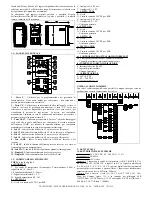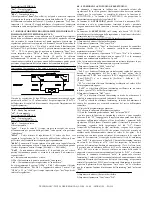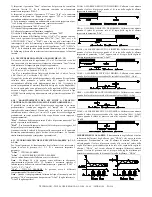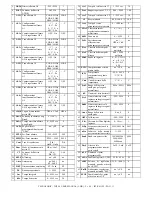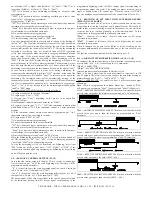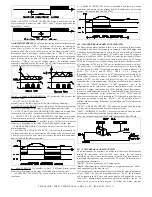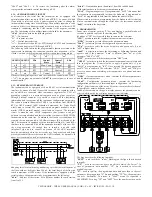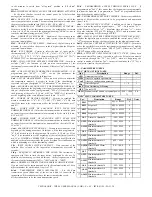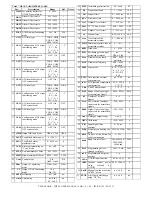
I : Auxiliary digital inputs
- : Interface not present
i = SUPPLY
L : 24 VAC/VDC
H : 90 ... 240 VAC
l = SPECIAL CODES
GUIDE TO THE POSSIBLE CODES
Not all the possible codes are correct, the following map it's useful to guide
to a correct code composition.
2 - TECHNICAL DATA
ELECTRICAL DATA
Supply: 24 VAC/VDC, 90 ... 240 VAC +/- 10%
Frequency AC: 50/60 Hz
Power consumption: 10 VA approx.
Input/s: 1 input for temperature probes (tc B,E,J,K,L,N,R,S,T,U; RTD
Pt100 IEC, Pt100 JIS, or mV signals) or normalized signals 0/4...20 mA,
0/1...5 V, 0/2...10 V. 2 optoinsulated digital inputs for free voltage contacts
or open collectors. 1 input for current transformer with K = 1/0,002 (Max.
200 mA)
Output/s: Up to 5 outputs. Relay (5 A-AC1, 2 A-AC3 / 250 VAC),10 A Max.
per Common (pin 12) ; or voltage for SSR drive (24VDC/0mA,
14VDC/20mA) or (for C1, C2) analogue with normalized signals 0/4...20
mA (R load < 600
Ω
), 0/2...10 V (R load > 100K
Ω
)
Auxiliary supply output: 18 VDC / 25 mA Max (only for norm. sign..)
Electrical life for relay output : 100000 operat.
Protection class against electric shock: Class II for Front panel
Insulation:
Reinforced insulation between the low voltage section (supply
and relay outputs) and the front panel; Basic insulation between the low
voltage section (supply and relay outputs) and the extra low voltage section
(inpus, outputs for SSR, analogue outputs); No insulation between inputs,
outputs for SSR and analogue outputs.
RS485 optoinsulated
MECHANICAL DATA
Housing: Self-extinguishing plastic, UL 94 V0
Dimensions: 48 x 96 mm DIN, depht 100 mm
Weight: 290 g approx.
Mounting: Flush in panel in 45 x 92 mm hole
Connections: 6.3 mm Faston terminals
Degree of protection of front panel : IP 54 mounted in panel with gasket
Pollution situation: Normal
Operating temperature: 0 ... 55 °C
Operating humidity: 30 ... 95 RH% without condesation
Storage temperature: -10 ... +60 °C
FUNCTIONAL DATA
Control: ON/OFF, PID
Measurement range: according to the used probe (see range table)
Display resolution: according to the probe used 1/0,1/0,01/0,001
Overall accuracy: +/- 0,15 % fs (input T), +/- 0,05 % fs (inputs I, V, W)
Sampling rate: 5 samples per second
Serial Interface : RS485 optoinsulated
Communication protocol: MODBUS RTU (JBUS)
Baud rate: Programmable from 300 ... 9600 baud
Action: 1C type according to EN 60730-1
Compliance: ECC directive EMC 89/336 (EN 50081-1, EN 50082-1), ECC
directive LV 73/23 and 93/68 (EN 60730-1)
MEASUREMENT RANGE TABLE
-99.9 ... 999.9
-9.99 ... 99.99
-0.999 ... 9.999
-999 ... 9999
0 ... 50 mV (0_50)
0/4..20 mA, 0/1..5 V,
0/2..10 V (gener.)
-99.9 ... 630.0 °C
-99.9 ... 999.9 °F
-99.9 ... 504.0 °R
-200 ... 630 °C
-328 ... 1166 °F
-160 ... 504 °R
Pt100 JIS
(Pt2)
-99.9 ... 850.0 °C
-99.9 ... 999.9 °F
-99.9 ... 680.0 °R
-200 ... 850 °C
-328 ... 1562 °F
-160 ... 680 °R
RTD Pt100 IEC
(Pt1)
-99.9 ... 600.0 °C
-99.9 ... 999.9 °F
-99.9 ... 480.0 °R
-200 ... 600 °C
-328 ... 1112 °F
-160 ... 480 °R
tc U
(u)
-99.9 ... 900.0 °C
-99.9 ... 999.9 °F
-99.9 ... 720.0 °R
-150 ... 900 °C
-238 ... 1652 °F
-120 ... 720 °R
tc L
(L)
-99.9 ... 400.0 °C
-99.9 ... 752.0 °F
-99.9 ... 320.0 °R
-270 ... 400 °C
-454 ... 752 °F
-216 ... 320 °R
tc T
(t)
-50.0 ... 999.9 °C
-58.0 ... 999.9 °F
-40.0 ... 999.9 °R
-50 ... 1760 °C
-58 ... 3200 °F
-40 ... 1408 °R
tc R (r)
tc S (S)
-99.9... 999.9 °C
-99.9 ... 999.9 °F
-80.0 ... 999.9 °R
-100... 1300 °C
-148 ... 2372 °F
-80 ... 1040 °R
tc N
(n)
-99.9 ... 999.9 °C
-99.9 ... 999.9 °F
-99.9 ... 999.9 °R
-200 ... 1370 °C
-328 ... 2498 °F
-160 ... 1096 °R
tc K
(CrAl)
-99.9 ... 950.0 °C
-99.9 ... 999.9 °F
-99.9 ... 760.0 °R
-200 ... 950 °C
-328 ... 1742 °F
-160 ... 760 °R
tc J
(J)
-99.9 ... 700.0 °C
-99.9 ... 999.9 °F
-99.9 ... 560.0 °R
-150 ... 700 °C
-238 ... 1292 °F
-120 ... 560 °R
tc E
(E)
400.0 ... 999.9 °C
752.0 ... 999.9 °F
320.0 ... 999.9 °R
400 ... 1820 °C
752 ... 3308 °F
320 ... 1456 °R
tc B
(b)
4 DIGIT with D.P.
4 DIGIT
PROBE
3 - INSTALLATION
MECHANICAL MOUNTING
:
The instrument, in DIN case 48 x 96 mm,
is designed for panel mounting. Make an hole 45 x 92 mm and insert the
instrument, fixing it with the provided special brackets.
We recommend to
mount the gasket to obtain an IP 54 front protection. Avoid to place the
instrument in areas with humidity or dirt. Connect the instrument as far as
possible from source of electromagnetic disturbances so as motors, power
relays, relays, electrovalves,etc. The instrument is removable from its
housing by the front side : is recommended to disconnect the power supply
from the instrument when is necessary to do this operation.
ELECTRICAL CONNECTIONS
: Carry out the electrical wiring
connecting only one wire for each terminal , according to the following
diagram, check that the power supply is the same as indicated on the
instrument and the loads current is not upper than the maximum current
admitted. The instrument, being a built in equipment with permanent
connection into a cabinet, is not furnished with internal device protecting
from overcurrent : it's recommended , therefore, to properly protect all the
electric circuits connected to the instrument, with devices (ex. fuses)
proportionate to the circulating currents. It's strongly recommended to use
cables with proper insulation, according to the working voltages and
temperatures. Furthermore, the input cable of the probe has to be kept
separate from line voltage wiring. If the input cable of the probe is
TECNOLOGIC - THP 94
USER MANUAL (I - GB) - Vr. 05 - ISTR 01195 - PAG. 13


